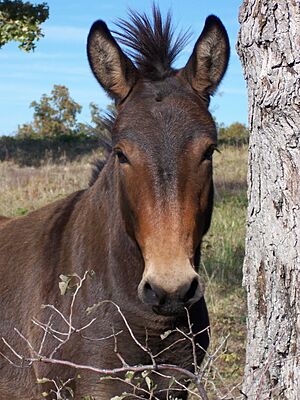Reproductive isolation facts for kids
Reproductive isolation is when different types of living things, called species, live near each other but cannot have babies together. This happens because of special features that stop them from mixing their genes.
The things that prevent species or groups of organisms from reproducing sexually are called isolating mechanisms. They act like barriers.
Usually, members of one species only mate with their own kind. But sometimes, different species do mate. If this happens, their babies might not grow properly, or they might not be able to have their own babies when they grow up.

When new species form from older ones, reproductive isolation is very important. It stops the new species from mixing back together and becoming one species again.
Contents
What Stops Species from Mixing?
Scientists have listed different ways that species are kept separate. These are the isolating mechanisms. They can happen before mating or after mating.
Before Mating: Pre-mating Mechanisms
These are things that stop different species from even trying to mate with each other.
- Temporal isolation: This means "time isolation." Individuals do not mate because they are active at different times. For example, one species might mate in the spring, while another mates in the fall.
- Ecological isolation: This means "habitat isolation." Individuals only mate in their favorite habitat or place to live. They do not meet others who live in different places, even if they are nearby.
- Behavioral isolation: Individuals of different species might meet, but they choose to mate only with their own kind. They might not understand the special signals or dances that other species use to attract a mate.
- Mechanical isolation: This happens when mating is tried, but it doesn't work. The bodies of the two individuals might be too different in size or shape for sperm to be transferred.
After Mating: Post-mating Mechanisms
These are things that stop a baby from developing or being able to have its own babies, even if mating happened. This is because the genes from the two different species do not work well together.
- Gametes not compatible: Sperm is transferred, but it cannot fertilize the egg. The sperm and egg just don't "recognize" each other.
- Zygote mortality: The egg is fertilized, but the very first cell of the baby (called a zygote) does not grow at all. It dies quickly.
- Hybrid inviability: A baby (called a hybrid embryo) starts to form, but it dies before it is born or very soon after. It cannot survive.
- Hybrid sterility: The hybrid baby is born and grows into an adult. But this adult cannot have its own babies. A mule is a famous example of this.
- Hybrid breakdown: The first generation of hybrid babies can survive and have their own babies. But when these second-generation hybrids try to have babies, they are often weak, cannot survive, or cannot have babies themselves.
Scientists are still learning about these mechanisms. Today, many researchers use more specific terms like "mate choice" or "hybrid incompatibility" instead of just "isolating mechanisms."
Images for kids
-
The flowers of many Angiosperm species have changed to attract only a few types of pollinators (like insects or birds). Their different shapes, colors, and smells are often due to how they evolved with their pollinators. This reliance on specific pollinators also acts as a reproductive isolation barrier.
-
In coral reefs, gamete incompatibility stops many different species of coral from forming hybrids.
-
Mules are hybrids that cannot have their own babies.
See also
 In Spanish: Mecanismos de aislamiento reproductivo para niños
In Spanish: Mecanismos de aislamiento reproductivo para niños





